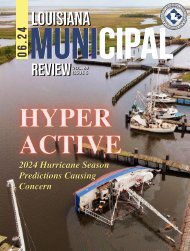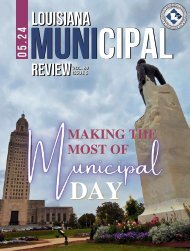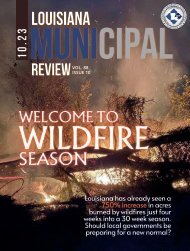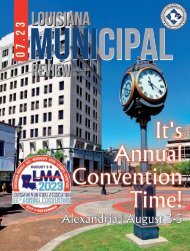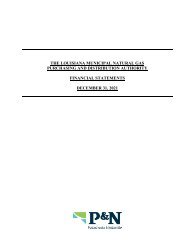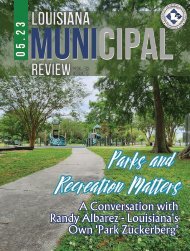GOHSEP Elected_Officials_Manual_2015
Create successful ePaper yourself
Turn your PDF publications into a flip-book with our unique Google optimized e-Paper software.
<strong>GOHSEP</strong> Louisiana <strong>Elected</strong> <strong>Officials</strong> Emergency Management <strong>Manual</strong><br />
Prepare + Prevent + Respond + Recover + mitigate<br />
»»<br />
Including sheltering service animals<br />
with persons with disabilities who<br />
utilize service animals – LRS 29:726 E.<br />
(20) (a) (i).<br />
The State EOP and specific components of it require<br />
annual review periods. For example, the portion of the<br />
plan that addresses pets and service animals must be<br />
reviewed on an annual basis by both <strong>GOHSEP</strong> and<br />
the Louisiana Department of Agriculture and Forestry<br />
(LDAF). The evacuation and sheltering component of<br />
the EOP must be submitted biennially.<br />
To ensure local and State governments remain<br />
capable to perform essential functions after a disaster<br />
or emergency, the State and Parishes are required to<br />
include continuity of government (COG) planning and<br />
continuity of operations (COOP) in their EOPs.<br />
Parish-Required Plans<br />
• Parish EOP – Required by LRS 29: 729 B., Parish<br />
EOP planning is discussed in the next section of<br />
this <strong>Manual</strong>.<br />
• Parish Hazard Mitigation Plans (HMP) –<br />
Required in order to be eligible for Hazard<br />
Mitigation Assistance (HMA) grants, the<br />
Parish HMP is discussed in the Local Hazard<br />
Mitigation Plans section of this <strong>Manual</strong>.<br />
Statute requires Parish-level<br />
planning.<br />
Other Requirements<br />
Beyond required planning initiatives, State and local<br />
authorities are required to perform some specific<br />
assessments and inventories that inform comprehensive<br />
planning efforts. Among those are inventories and<br />
assessments that apply to providing emergency support<br />
and aid to at-risk populations. Typically, at-risk<br />
populations are those defined as children, elderly, those<br />
who are economically disadvantaged, those with<br />
disabilities and those whose first language is not English,<br />
among others.<br />
At-Risk Populations: Emergency Rules +<br />
Standards For Mandatory Evacuations +<br />
Sheltering<br />
Every Parish and municipality must perform a biennial<br />
risk assessment for its at-risk populations. The risk<br />
assessment should consist of a survey of people<br />
living within the corporate limits (municipal risk<br />
assessment) and outside of the corporate limits (Parish<br />
risk assessment). The survey identifies those in each<br />
category of the at-risk population and essential workers<br />
to determine whether individuals may need sheltering<br />
in a general population or a special-needs shelter.<br />
Every Parish and municipality must prepare an<br />
inventory of all available modes of transportation for<br />
use in a mandatory evacuation. A copy of the municipal<br />
AT-RISK INVENTORY<br />
SHOULD IDENTIFY:<br />
• At-risk populations by categories<br />
defined by the Louisiana Department of<br />
Health and Hospitals (DHH).<br />
• Essential workers needed to assist atrisk<br />
individuals.<br />
• Transportation assets needed to<br />
develop an evacuation and sheltering<br />
plan for each category.<br />
2.2 Required Plans Page 3 of 5



